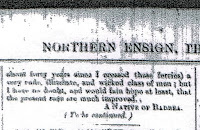Article XVI written by Alexander Gunn was published in
the Northern Ensign on 29 September 1881 – Part A
“In my last I said that in all the schools in the
Highlands and Gaelic-speaking districts, Gaelic should be taught. It is a
branch of education as essential to a Highlander as English is to the
Lowlander. How can the Highlander profitably listen to a preacher in his
mother-tongue, unless he can read the scriptures in that language? Why force a
strange or foreign language down the Highlander’s throat, and deprive him of
that which he drank in with his mother’s milk? As well compel the English
speaking portion of our population to learn the Gaelic as force the Highlander to
learn English at the expense of losing his mother-tongue. In some parts of the
western Highlands the Board Schools teach the Gaelic; why not throughout the
entire length and breadth of the Highlands?”
“The Berriedale school was not a celebrated institution,
but it was a model one, I as far as master and pupils made the best and the
most of the few advantages they had. Mr Mackay was a persevering, painstaking
man, who did all that he did in the very best possible manner, and he was
rewarded by having the sympathy and goodwill of both parents and pupils. Some
of his pupils studied for the ministry, and some for the medical profession and
both have been able to creditably hold their ground in their several walks.”
“There was a small circulating library connected with the
school, and the books were issued gratis to the scholars, and supplied us with
both useful and interesting reading. Foremost in this list was the
world-renowned “Pilgrims Progress” in English and Gaelic, a book that has been
published in more languages than any other except the Bible."
 |
Pilgrim's Progress in Gaelic
|
"Also Bunyan’s
“Holy War,” as well a “Visions of Heaven and Hell.”
"The library also comprised
voyages and travels of a very interesting and instructive nature, such, for
instance, as the voyage of the “Bounty” with her Captain Bligh, and the details
of the mutiny of the crew. Perhaps a brief sketch of this story might be
interesting to your readers:- On the 28th
April, 1786, Fletcher Christian, master’s mate, infuriated by some insulting
word by Captain Bligh, suddenly, and to all appearances without any
understanding among the crew, incited a mutiny, and early in the morning the
mutineers surprised Captain Bligh, bound him and carried him on deck."
 |
Fletcher Christian and the mutineers seize HMS Bounty on 28 April 1789.
Engraving by Hablot Knight Browne, 1841
|
"In a few
moments, he and 18 of his officers and men who had remanded loyal to their
commanding officer and their duty were cast adrift in an open boat, with
provisions for only five days. Captain Bligh, by his admirable prudence,
courage and firmness, so husbanded the small stock of provisions, and the course of the boat was so wisely
directed, that at the end of 43 days, after experiencing a violent gale, and
enduring almost the pangs of starvation, the boat came to anchor off the coast
of Timor without the loss of a single man, having traversed a distance of 3618
miles."
 |
Fletcher Christian and the mutineers turn Lieutenant
William Bligh and 18 others adrift. 1790 painting by Robert Dodd.
|
"In the meantime the mutineers finally landed at Pitcairn Island, and
burned the ship. They afterwards passed through various vicissitudes’, the
natives killing a number of the British and the British killing a number of the
natives."
 |
Bounty Bay on Pitcairn Island, where HMS Bounty was
burned on 32 January 1790.
|
"No one knew or heard what became of the mutineers until 1808, nineteen
years after the mutiny, an American vessel touched at the Island , when the
commander, Captain Taylor, discovered to his surprise that the island was
inhabited by the descendants of the mutineers. A number of young people were
found speaking English and Tahitian with fluency, living simple harmless lives,
and free from the voices of the ordinary South Sea Islanders. In 1814 two
British frigates, cruising in the Pacific, reached Pitcairn Island. The inhabitants
were found to be peaceful, law-abiding, and religious, ruled over a patriarchal
fashion by John Adams. The quondam mutineers had trained the people in the ways
of frugality and industry. He also held religious services, reading the Church
of England prayers. In 1830 the little community numbered 79 persons, and it
began to feel that it had outraged the capabilities of the Island, which
measured only four square miles of area. Latterly the people agreed to emigrate
in a body to Norfolk Island, sixty degrees west of Pitcairn, and there we will
leave them and their interesting history in the meantime.”
My Comments:
There is plenty of further detail on-line about the Bounty such as at: https://en.wikipedia.org/wiki/Mutiny_on_the_Bounty
It is not clear which version of the Bounty story Gunn
read but it may have been: William
Bligh’s Narrative of the Mutiny on the Bounty. London: George Nicol, 1790
It is not surprising that the story of the Bounty intrigued
the pupils at Berriedale school. The sea was such an important part of their
lives going right back to the days of press-gangs where local young men were
taken forcibly to be disciplined and serve with a naval force (as was Gunn’s
grandfather), to the management of their fishing boats and crews, all would have
been aware that a real mutiny at sea was a rare and significant event.












































